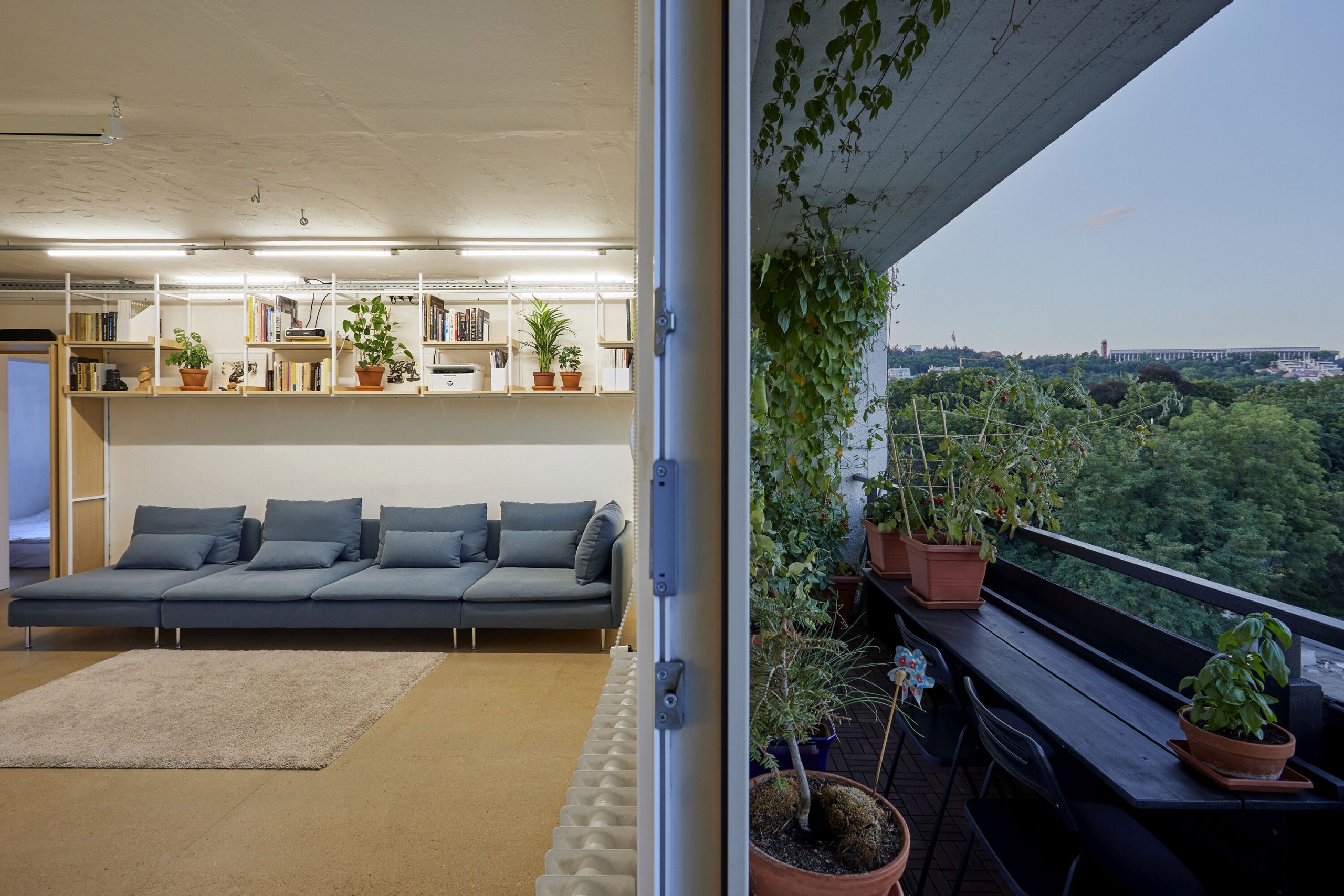When an architect remodels his own apartment.
I am an architect. I live with my wife and daughter on the 11th floor of a panel building in Prague 5. I get up early in the morning, I haven’t smoked for years, I don’t argue, I listen to classical music for work, I drink coffee with a bit of milk, I like machines and mechanisms, and I’m glad to know how they work. I like decency, naturalness and honesty, even in building materials, their roughness, smoothness, and ageing. I like my job. I’m a perfectionist.


The renovated apartment is to serve our family of three. We need a large living room to be the heart of the apartment. It must fit a kitchen, large table, exercise area, and perhaps even a children’s slide. Therefore, it occupies one entire apartment section, defined by supporting panels. There is no space for an entrance hall and other spatial nonsense, of which there are already more than enough in the common areas in our building. We don’t have a TV; we watch movies and fairy tales on a projector. I like to grow plants, so the windows of the loggia, from which there is a view of the whole of Prague, are shaded by climbing cucumbers in the summer. I carefully check their correct development every morning. Some tomatoes grow in their pot; others share a large self-watering pot with ivy. I like to carefully compare the fresh shoots of our five-leafed bougainvillaea, which extend from the large flower pots at the other end of the loggia, on the wires on the walls and ceiling of the loggia so that they will stretch and grow nicely.

In addition to the living room, we need a room for our daughter. It is almost a mirror image of the guest room, which also serves as an office. They are connected by sliding doors so that we can run around the built-in cabinets. Initially, there used to be a living room on this apartment side without a loggia! The loggia was only allowed to be entered from a single residential, privileged room. That’s over today. We turned the entire layout around, and the loggia is now accessed from the living room.
In addition to the rooms and built-in wardrobes, this second section of the apartment includes a toilet, a niche with a washing machine and a comfortable bathroom with a bathtub. We no longer need a fan in the bathroom. It now has a window through which we can reliably air it out in a few seconds. And most importantly, it now has natural light, which is a luxury in a panel building.

Our HOA is strict. Among other things, it prohibited any jamming of distribution lines into load-bearing walls or ceiling panels. We did not want to lower the ceilings with plasterboard ceilings, where it is possible to hide part of the wiring. I consider height to be one of the most valuable values of space. And so we are probably the only ones in the building who really respected it and didn’t jam anything, not even vertical electrical distributions. Everything is led along the surface, just like the original heating distribution. But I don’t mind. I like meaningful constraints that simplify my decision-making and, at the same time, create my own natural aesthetic. Bricklayers, plumbers and electricians liked this decision a little less, as they had to hit precisely the axes of everything: rooms, openings and tiles.

All new distribution networks are laid out in precise geometrical networks. I also told them they couldn’t cut the little 10×10 tiles because I had it figured out exactly, so they wouldn’t have to cut them. They were also sometimes surprised that I didn’t want them to level and plaster the spots and unevenness in the plaster after tearing down the polystyrene insulation of the ceilings. We proceeded in the same way when adjusting the unevenness that remained on the ceilings after the demolition of all the load-bearing partitions. The masons were only supposed to clean them roughly, and they were supposed to impregnate and whitewash the whole thing. I don’t mind inequalities in this case at all; I even like them. It’s honest decoration, and it’s free. Of course, the masons were surprised when I was critical about millimetres of unevenness in the new walls or in the joints of the new floor, which should always be the same on the walls. I hinted to them that I was concerned with the contrast between the original building and the newly inserted elements, but I didn’t explain for a long time because even then, it probably wouldn’t be in line with their truth. I didn’t even explain to them that I don’t mind traces of original construction interventions or walls being removed. I did not even explain that it is almost the same as when historical monuments are restored, where, according to one philosophical current, it is desirable to recognize traces of interventions in individual periods of development. However, I understand that using this method in a pane building is somewhat unusual. Still, I think it’s legit; the house is almost 50 years old.
Repairing an apartment in a panel building does not have to be cheap. There is a lot of carpentry in the apartment. We also have ash veneer inside the cabinets because it was meant to be. Our bedroom is narrow, just the width of the bed, but one day it will be completely panelled, like a cabin, also with ash. Today, however, I am pleased with the scratched plaster and the original panel with its countless “imperfections”, which I painted white. It was supposed to stay grey, but it’s painted white because I wasn’t paying attention and was a few minutes late. My daughter, almost three years old at the time, had already started painting. We misunderstood. So I have already painted one concrete wall white to be the same everywhere.
Other images can be seen in the gallery down
Studio: RDTH architekti
Author: René Dlesk and Tamara Kolaříková
Project location: Prague, Czech Republic
Project year: 2018
Completion year: 2021
Usable floor area: 79 m² apartment and 6 m² loggia
Photographer: Filip Beránek
About Studio
Studio RDTH architekti was founded in Prague in 2017 by Tamara Kolaříková (Horová) and René Dlesk. In their current practice, they mainly focus on private projects of small and medium scales.

Tamara Kolaříková and René Dlesk

